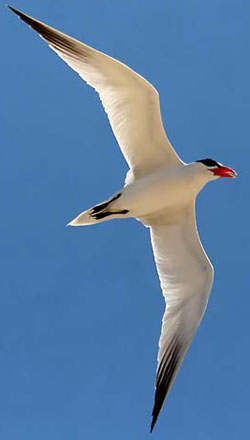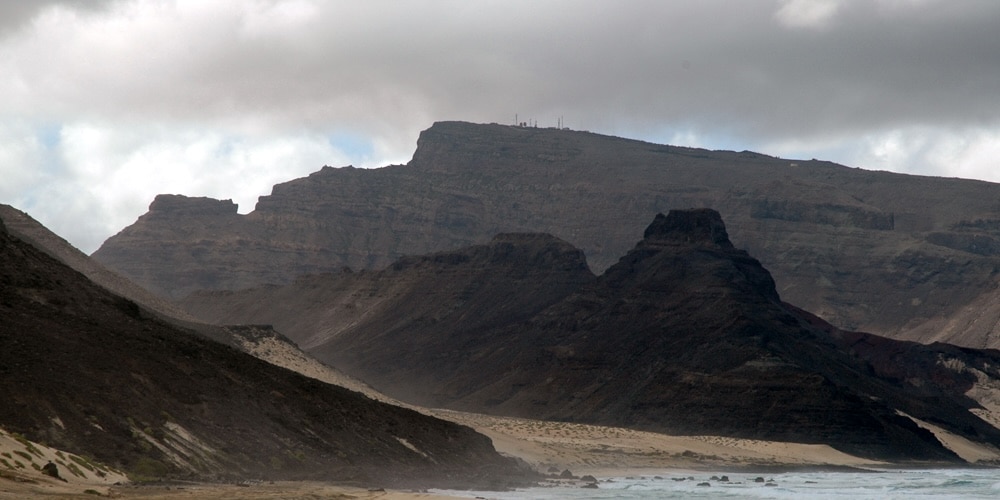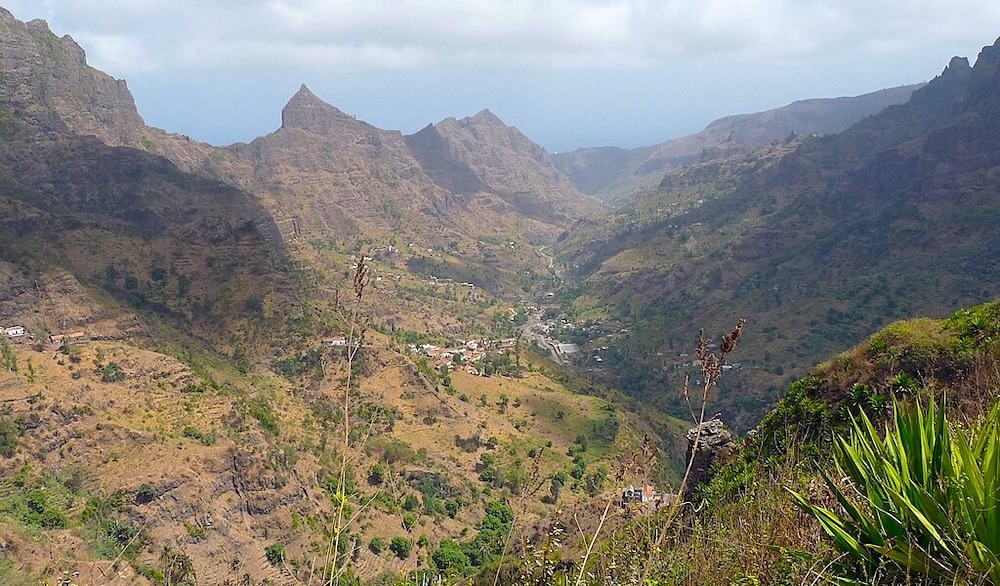Cabo Verde

Cabo Verde, is an island country and archipelagic state of West Africa in the central Atlantic Ocean, consisting of ten volcanic islands with a combined land area of about 4,033 km2 (1,557 square miles). These islands lie between 600 and 850 kilometres west of Cap-Vert, the westernmost point of continental Africa. The Cape Verde islands form part of the Macaronesia ecoregion, along with the Azores, the Canary Islands, Madeira and the Savage Isles. The country is a horseshoe-shaped cluster of ten islands (nine inhabited) and eight islets. The islands are spatially divided into two groups: The Barlavento Islands (windward islands): Santo Antão, São Vicente, Santa Luzia, São Nicolau, Sal, Boa Vista; and the Sotavento Islands (leeward): Maio, Santiago, Fogo, Brava. The largest island, both in size and population, is Santiago, which hosts the nation’s capital, Praia, the principal urban agglomeration in the archipelago.
Though Cape Verde’s islands are all volcanic in origin, they vary widely in terrain. A still-active volcano on the island of Fogo is the highest point on the archipelago (elevation 2,829 meters). Three of the Cape Verde islands, Sal, Boa Vista, and Maio, are fairly flat, sandy, and dry; the others are generally rockier with more vegetation. Extensive salt flats are found on Sal and Maio. On Santiago, Santo Antão, and São Nicolau, arid slopes give way in places to sugarcane fields or banana plantations spread along the base of towering mountains. Ocean cliffs have been formed by catastrophic debris landslides.

São Vicente Island – ©Henryk Kotowski CC BY-SA 3.0 via Wikimedia Commons
Cape Verde’s climate is milder than that of the African mainland because the surrounding sea moderates temperatures on the islands and cold Atlantic currents produce an arid atmosphere around the archipelago. Conversely, the islands do not receive the upwelling (cold streams) that affect the West African coast, so the air temperature is cooler than in Senegal, but the sea is warmer. Due to the relief of some islands, such as Santiago with its steep mountains, the islands can have orographically induced precipitation, allowing rich woods and luxuriant vegetation to grow where the humid air condenses soaking the plants, rocks, soil, logs, moss, etc. On the higher islands and somewhat wetter islands, exclusively in mountainous areas, like Santo Antão island, the climate is suitable for the development of dry monsoon forests, and laurel forests.

île de Santiago – ©Ji-Elle CC BY-SA 3.0 via Wikimedia Commons
Average temperatures range from 22 °C in February to 27 °C in September. Cape Verde is part of the Sahelian semi-arid belt, with nothing like the rainfall levels of nearby West Africa. It rains irregularly between August and October, with frequent brief heavy downpours. A desert is usually defined as terrain that receives less than 9.8 inches of annual rainfall. Sal’s total of 5.7 inches confirms this classification. Most of the year’s rain falls in September. Sal, Boa Vista, and Maio have a flat landscape and arid climate, whilst the other islands are generally rockier and have more vegetation. Because of the infrequent occurrence of rainfall, where not mountainous, the landscape is so arid that less than two percent of it is arable. The archipelago can be divided into four broad ecological zones –arid, semiarid, sub-humid and humid, according to altitude and average annual rainfall ranging from less than 4 inches in the arid areas of the coast as in the Deserto de Viana 2.6 inches in Sal Rei
to more than 39 inches in the humid mountain. Most rainfall precipitation is due to condensation of the ocean mist. In some islands, like Santiago, the wetter climate of the interior and the eastern coast contrasts with the drier one on the south/southwest coast.
Birding Cape Verde
In Cabo Verde forest cover is around 11% of the total land area, equivalent to 45,720 hectares of forest in 2020, triple what it was thirty years before. Naturally regenerating forest covered 13,680 hectares and planted forest covered 32,040 hectares. 100% of the forest area is under public ownership.

Vale do Paúl, Santo Antão – ©CaptainDarwin CC BY-SA 4.0 via Wikimedia Commons
Cape Verde’s isolation has resulted in the islands having several endemic species, particularly birds and reptiles, many of which are endangered by human development. Endemic birds include Alexander’s Swift Apus alexandri, Bourne’s Heron Ardea purpurea bournei, the Raso Lark Alauda razae, the Cape Verde Warbler Acrocephalus brevipennis, and the Iago Sparrow Passer iagoensis. The islands are also an important breeding area for seabirds including the Cape Verde shearwater. Reptiles include the Cape Verde Giant Gecko Tarentola gigas.
-
Wikipedia
GNU Free Documentation License
https://en.wikipedia.org/wiki/Cape_Verde
-
Number of bird species: 298
(As at February 2025)
Number of endemics: 5
Cape Verde Buzzard Buteo bannermanio
Alexanders Swift Apus alexandri
Razo Skylark Alauda razae
Cape Verde Swamp-Warbler Acrocephalus brevipennis
Cape Verde Sparrow Passer iagoensis
Number of endemics: 4 Breeding Endemics
Fea's (Cape Verde) Petrel Pterodroma feae
Cape Verde Storm-petrel Hydrobates jabejabe
Cape Verde Shearwater Calonectris edwardsii
Boyd's Shearwater Puffinus boydi
-
Avibase
PDF ChecklistThis checklist includes all bird species found in Cape Verde , based on the best information available at this time. It is based on a wide variety of sources that I collated over many years. I am pleased to offer these checklists as a service to birdwatchers. If you find any error, please do not hesitate to report them. -
E-Bird
PDF ChecklistThis checklist is generated with data from eBird (ebird.org), a global database of bird sightings from birders like you. If you enjoy this checklist, please consider contributing your sightings to eBird. It is 100% free to take part, and your observations will help support birders, researchers, and conservationists worldwide. -
Wikipedia
Annotated ListThis is a list of the bird species recorded in Cape Verde. The avifauna of Cape Verde include a total of 289 species, of which 5 are endemic, and 5 have been introduced by humans.
-
Aves De Macaronesia: Azores, Madeira, Islas Canarias, Cabo Verde
(Field Guide to the Birds of Macaronesia: Azores, Madeira, Canary Islands, Cape Verde) By Eduardo García-del-Rey | Lynx Edicions | 2011 | Hardback | 342 pages, 150 colour plates, 230+ colour distribution maps | Text in Spanish | ISBN: 9788496553705 Buy this book from NHBS.com -
Birds of the Atlantic Islands: Canary Islands, Madeira, Azores, Cape Verde
By Tony Clarke, Chris Orgill & Tony Disley | Christopher Helm | 2006 | Paperback | 368 pages, 56 colour plates, b/w photos, b/w maps | ISBN: 9780713660234 Buy this book from NHBS.com -
Birds of the Cape Verde Islands
By Eduardo García-del-Rey | Editorial Sociedad Ornitológica Canaria | 2016 | Paperback | 235 pages, colour photos, tables | Out of Print | ISBN: 9788460695288 Buy this book from NHBS.com -
The Birds of Cape Verde Islands
| An annotated checklist | By Cornelis J Hazevoet | BOU | 1995 | Hardback | 192 pages, 48 col plates, tabs, maps | Out of Print | ISBN: 9780907446170 Buy this book from NHBS.com
-
African Bird Club
WebsiteCabo Verde is an archipelago of 10 islands and several islets in the eastern Atlantic Ocean with a combined total land area of 4,033 km²... -
Biosfera
WebsiteThe Mission of Biosfera is to promote the defence of the conservation of coastal and marine species and their habitats and mobilise Cape Verdean civil society to protect the environment. -
Birds of the Cape Verde Islands (SOC)
Facebook PageThe official LIST OF BIRDS OF THE CAPE VERDE ISLANDS, compiled by Sociedad Ornitologica Canaria (SOC). Submit your records by adding date, location... -
West African Ornithological Society
WebsiteThe West African Ornithological Society grew out of the Nigerian Ornithologists
-
*List of protected areas in Cape Verde
InformationSatellite ViewNature reserves, natural parks, RAMSAR sites, IBAs, etc. -
IBA Ilhéu de Curral Velho
InformationSatellite ViewThe Ilhéu de Curral Velho and adjacent coast Important Bird Area lies in the southeastern part of the island of Boa Vista in the Cape Verde archipelago off the coast of north-west Africa in the Atlantic Ocean. It is a 986 ha site consisting of the Ilhéu de Curral Velho, as well as the area opposite it on Boa Vista centred on the deserted village of Curral Velho. It was designated as a Ramsar wetland of international importance. The islet is a nesting area for the brown booby, magnificent frigatebird and Cape Verde shearwater. Birds breeding on the adjacent mainland coast include Iago sparrow, common kestrel, common quail, cream-colored courser, Kentish plover and many other species. -
IBA Ilhéu dos Pássaros
InformationSatellite ViewIt is an important nesting site for white-faced storm petrel and band-rumped storm petrel -
IBA Ilhéus do Rombo
InformationSatellite ViewThe island group has been identified as an Important Bird Area (IBA) by BirdLife International because it supports seabird colonies as well as peregrine falcons and Iago sparrows. Birds include the Frigate bird (Pelagodroma marina) numbering around 1,000 in 1989, the Boyd's shearwater (Puffinus boydi), Oceanodroma castro, Bulwer's petrel (Bulweria bulwerii), the brown booby (Sula leucogaster) (50 pairs between 1986 and 1990) and Phaethon aethereus (only 5-10 couples between 1986 and 1990). Also there is a subspecies of the Peregrine falcon named madens, discovered in the mid-1960s with only 15 to 20 pairs -
IBA Wetland Lagoa do Rabil
InformationSatellite ViewThe Lagoa do Rabil (Rabil lagoon) is a wetland site in the Cape Verde archipelago, on the island of Boa Vista. -
NP Fogo
InformationSatellite ViewThe volcano area of Fogo is an Important Bird Area. Key bird species are Fea's petrel, Boyd's shearwater and Cape Verde swift. The ocean around the island of Fogo is another Important Bird Area covering 2,473 km2 (955 sq mi) -
NP Monte Gordo
InformationSatellite ViewFauna includes the Chioninia fogoensis (Fogo skink), Cape Verde wall gecko (Tarentola caboverdiana),[4] Fea's petrel (Pterodroma feae) and Cape Verde warbler (Acrocephalus brevipennis). -
NR Morro Negro
InformationSatellite ViewThe hill forms a part of the Turtle Nature Reserve (Portuguese: Reserva Natural Tartaruga), which covers 14.39 km2 of land area and 134.36 km2 of marine area. The reserve protects the beaches as nesting areas for its turtle population, and its wetlands and salty lands for birds.
-
eBird
SightingseBirding This Month
-
Almodôvar Birding Center and Observatory
Tour OperatorOur Cape Verde Tour takes you on an exciting birding adventure where you can observe species such as the Red-billed Tropicbird, White-faced Storm-Petrel, Black-capped Petrel and more. -
BirdFinders
Tour Operatorfive endemic species – Cape Verde Sparrow, Cape Verde Buzzard, Alexander’s Swift, Cape Verde Swamp-warbler and Razo Skylark – and several endemic sub-species, plus Red-billed Tropicbird and other seabirds and extralimital Western Palearctic birds including Grey-headed Kingfisher and Black-crowned Sparrow-lark... -
BirdQuest
Tour OperatorCAPE VERDE ISLANDS – Endemics, Seabirds & Vagrants of some remote Atlantic islands -
Birding Africa
Tour OperatorCape Verde, Azores, Madeira, Canary Is. -
Rockjumper
Tour OperatorWest Africa - Cape Verde to Madeira -
Sal Island Bird Tour
Local TripsOur guided bird-watching tours offer a front-row seat to this avian spectacle, providing not only an opportunity to marvel at the feathered residents but also to explore the stunning landscapes that serve as their habitat. Join us for an unforgettable adventure as we unveil the secrets of Sal’s avian wonders in a friendly and welcoming atmosphere.
-
2018 [01 January] - Boa Vista, Cape Verde January 8 – 15 th 2018 Hans - Åke & Karin Gustavsson - Boa Vista
PDF ReportThis short report contains the bird observationsmade on the island of Boa Vista during a one-week charter trip together with my wife. Most of our stay was spent relaxing and birding was confined to early morning walks close to our hotel as well as during a half day guided trip to the southern and interior parts of the island andduringa half day visit to the Rabil Lagoon by taxi. -
2018 [03 March] - Volker Hesse
PDF ReportThis is one of the most popular sites on Boavista as there is quite a few rarities that have turned up here. During my stay there was nothing of great excitement. A few waders were present, also Spectacled Warbler and Iago Sparrow. All lark species were there too, they were only seen along the 4WD-track. Two Caspian Terns were the biggest surprise. During migration this site is said to be one of the best on the island... -
2019 [04 April] - Dani Lopez-Velasco
PDF ReportAll endemics were seen on this year´s tour, with highlights including fantastic views of breeding Red-billed Tropicbirds, hundreds of Cape Verde Shearwaters, many Boyd´s and several (Cape Verde) Fea´s Petrels and White-faced Storm Petrels coming to the chum on a pelagic off Sao Nicolau, as well excellent looks at endemic Cape Verde Warblers, Cape Verde Swifts and Iago Sparrows on Santiago. -
2023 [08 August] - Jack Bucknall
PDF ReportBetween 31st July-14th August 2023, my wife and I visited Boa Vista for our summer holiday, staying at the Hotel Riu Palace in the far NW of the island. Whilst this was not strictly a birding trip, it would have been rude not to have taken in some of the island’s goodies, including some Western Palearctic (WP) megas. Despite limited transport, I still managed to get eight lifers over the course of the two weeks. -
2024 [05 May] - Mark Beaman
PDF Report...The star bird of the interior barrages was the attractive endemic ‘Bourne’s’ Heron, the form bournei usually being treated as a subspecies of the Purple Heron. On this tour, second in line were the vagrant Yellowbilled Egrets that we found at Barragem de Faveta on each visit, while other waterbirds at the barrages included Common Moorhen, Black-winged Stilt, Kentish Plover, Common Sandpiper, Common Greenshank, Glossy Ibis, Eurasian Spoonbill, Black-crowned Night Heron, Little, Western Cattle and Great Egrets, and Grey Heron...
-
Aves de Cabo Verde
WebsiteOn line version of a bird book -
Birdwatching in Cabo Verde
WebpageBirdwatching in Cabo Verde offers an array of ornithological treasures spread across the islands, providing a diverse and enriching experience for bird enthusiasts. Cabo Verde’s unique ecosystems draw a variety of bird species, making it an ideal destination for birdwatching aficionados. -
Birdwatching in the Cape Verdes
WebpageUnique Palearctic endemics and rare vagrant seabirds... -
Cape Verde Shearwater
WebpageImage etc.

